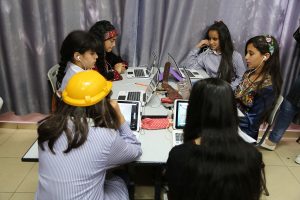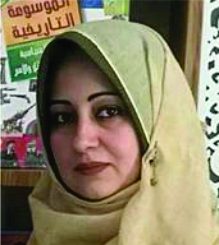As part of my interest in education worldwide, I am very keen to give my students information through the most modern up-to-date technology available. I also believe in quality education, which, according to the United Nations, is the fourth Sustainable Development Goal that contributes to the achievement of other goals.
I can contribute to quality education through various roles and at different levels. Inside the classroom, for example, and after reviewing the results of school exams, I noticed that some students are weak in more than one subject, but the weakest seems to be science. Various studies recommend using augmented reality in education as a form of learning, through smartphone applications.

Having to live with the constant and frequently unpredictable electricity cuts that are a daily reality in the Gaza Strip and trying to cope with its negative impact on both the learning process inside the classroom and the ability to study at home, inspired me to create an application that would allow my students to make best use of the time when electricity is in fact available. I was sure that by utilizing augmented reality to explain important learning material, the achievement levels of our students could be increased. I called the application TAJSEEM (Arabic for realization), and there are two stages: the first covers the science and geography curriculum of fifth grade, while the second stage covers the science curriculum for seventh grade. This application aims to help raise students’ grades by engaging them inside and outside the classroom, giving them vivid and memorable learning experiences that hopefully will last even after they graduate.
TAJSEEM is free and can be downloaded via Google play. It has been used and positively evaluated by students and parents.
The application has many unique features. It projects 3D models for a myriad of subjects, has audio to make it easier for students to repeat and comprehend the explanation, and features images and photos to create visual impact and foster a wider understanding. But I also had another goal, namely to change the methods of teaching science, to shift from traditional ways to the use of modern techniques. Furthermore, this was a way of demonstrating to students that they can use their mobile phones in a positive manner and enhance their learning rather than just play games and watch movies.
We soon noticed that students began to use the application for the science and geography curriculum, which was a great success and a unique and new experience not only for them but also for their parents. After downloading the application, students can scan a page of their textbook where there is, for example, a picture of a body limb or a diagram representing an operation on an organ. The application recognizes the diagram or the image and transforms it into a 3D model, giving full details in audio.
Teachers were equally happy with the experience because the application supports their explanation of a topic at hand and allows them to visualize text from a book through 3D models. Similarly, parents were aided in their efforts to explain to their children some of the most difficult scientific topics.
TAJSEEM has recently been presented at the “Startup Weekend Education Gaza,” organized by Google, which targets entrepreneurs and innovators who have creative ideas that advance education. I was very proud to introduce my application to a group of professors, specialists, and mentors from Palestinian and international universities who selected me to become a member of the committee of distinguished teachers in the Gaza directorate.
I am certain that what I have created is just the beginning of what is known as digitalizing education. In a world in which technology is evolving very fast, we should create more applications that allow students to better familiarize themselves with the information they are studying. We need applications that help them link information to its usage in the real world. Many students question their ability to use the information they learn in their day-to-day life. I believe that these are valid questions and that students must be made aware of the importance of the information they receive. But how can they be more aware of the importance of education? They must be shown where education can lead them. By showing them what these little pieces of information can accomplish, we can make sure that students will do better in school and develop goals and aspirations. Mobile applications are an easy and smart way of presenting the information they need, giving them access to quality education. I have taken a very simple step in that direction and hope that others may follow on this path.



